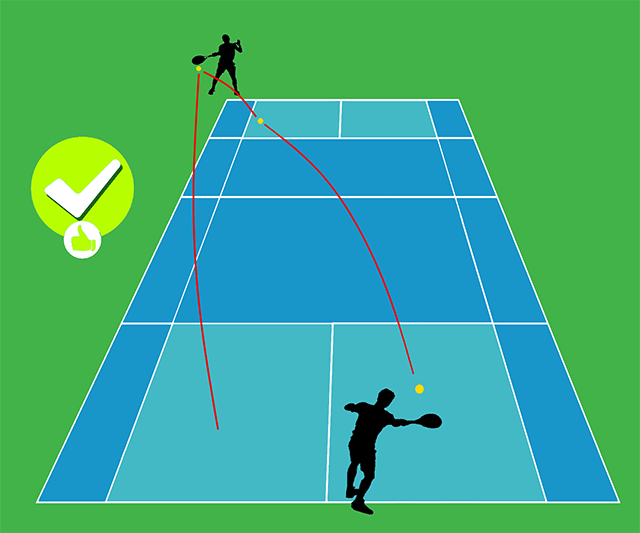Naked Tennis is a new sport invented by Daniele Favero from Italy in December 2020. It is not tennis played naked, but a variant of tennis played without the net.
Equipment Required: same as tennis
Sport Description
To play naked tennis you can use a standard tennis court, but with some simple modifications. You don't need the net or even the central line of the service. Instead you need a line that divides the baseline rectangle (the so-called no man's land) in two halves. To play doubles, simply extend the horizontal service line to include the side bands.
For our purposes it is not necessary to delete the existing lines of the standard court, we can simply ignore the ones we don't need and draw the ones we need. These new lines can stay and won't bother if you want to play tennis the traditional way in the same court.
 Naked Tennis court
Naked Tennis courtThe first big difference from tennis is the serve. In this variant you don't serve towards the service area but towards each of the 2 halves in which the no-man's-land is divided. You don't have 2 attempts (first and second serve) but only one, as the area to hit is bigger.
Another difference is that right - left alternation is not needed. Each player can choose to serve towards the opponent's left or right rectangle, he just has to tell it first. If he wants to serve 5 consecutive times to the left, he can do it. Furthermore, the serving player is not asked to serve diagonally (from left towards opponent's left box and from right towards opponent's right box. He can choose his position anywhere behind the baseline.
After the serve, players can only hit the opponent's no-man's land. Aside from that, the game plays like standard tennis.
However, if a player hits the ball by a volley and sends it into the opponent's central area, he "conquers" (or "unlocks") this area. This happens at the exact moment the ball touches the central area after a volley (the service line is part of the central area). At that point the playing area becomes the same as standard tennis for both players. On the other hand, if the player, by the first volley, sends the ball into the no man's land, the central area remains off limits.
A player is not bound to stay in his own half during the game, he can also cross over to the opponent's side. However, he must respect fair play. If he does not maintain an adequate distance of at least 1.5m (5 ft) and obstructs the opponent during the execution of the shot, the point is lost or repeated (char umpire decides the severity of the fault). If a player touches the ball with any part of the body other than the racket, he loses the point.
The same rules apply for doubles, a player can move freely even in the opponent's field. It is not necessary to rotate the turns of service, the same player can always serve within the team.
The score is the same as for standard tennis or you can use a simplified system: each set corresponds to a tie break of 35 points (this is about the points a player makes to win a traditional set). Change of ends is done when the leading player reaches a multiple score of 10. So for example you change ends on 10-5, or 18-20 or 30-26. If, for some reason, one player prefers to play in one end and the opponent agrees, there is no need to change ends. The agreement is renewed at next change of ends or, if a player disagrees, players change ends.
Less stringent rules are desirable in the construction of racquets to allow players freedom to experiment. However, the racket must be a passive instrument without any source of energy.
It may be necessary to redefine the areas of the court (no man's land and central area) to make the game interesting and find other weak points, difficult to say until you try to play at a high level with very fast balls.
Rate this Sport
What do you think about this 'sport'? Please rate it on its potential.
Note
Related Pages
- See other New Sports
- About Tennis
- Complete list of unusual sports
Disclaimer


 Current Events
Current Events